Today’s modern kitchen is usually full of plastic food storage containers, plastic bags and wraps, which is not the most sustainable food storage containers. It was not always the case, as people used to store food in glass or ceramic and even paper. Plastic wrap was first invented in 1908 and we all know how popular Tupperware products are, that many people would call any plastic storage container Tupperware.
Most food storage containers are made of plastic. New research is showing us that plastic is bad for your health and the environment, so we want to have phthalate free food storage containers. It is time to say goodbye to plastic, detox your kitchen and get the safest food storage containers. So what are the alternatives?
What makes Plastic Bad?
1. Why is Plastic Bad for your Health?
BPA’a and phthalates from plastic food storage containers can leak into food or liquids. The risk increases when the plastic container is heated, leading to disturbing health hazards like cancer and endocrine imbalances.
- Chemicals from plastic containers can leak into food and even more so when it is exposed to heat.
- Never heat food in the microwave using plastic.
- Steam and heat from the dishwasher and even ultraviolet rays from the sun, can also unlock harmful chemicals.
- Acidic foods like tomatoes, can interact with plastic, leading to toxic chemicals leaking into the food. Don’t store anything acidic in plastic, use glass instead.
Getting rid of plastic is your easiest option to protect yourself. Don’t use plastic water bottles, and specially not if they have been left in a car and exposed to heat, as chemicals from the plastic can leak into the water. New research has linked that to a cause of breast cancer in women.
2. Why is Plastic Bad for the Environment?
Most plastic is made from petrochemicals that are derived from fossil fuels and are not sustainable. Not all reusable plastic containers are recyclable. Most plastic unfortunately end up in landfill and also the ocean, where it hurts and kills aquatic life.
So we now know that plastic is not only bad for the environment, it is also bad for our health. At the moment we don’t have a plastic option that is safe, so let’s have a look at the safest food storage containers that are healthy alternatives to plastic, and are also phthalate free food storage containers.
Sustainable and Healthy Alternatives to Plastic for Storing Food:
- Beeswax wraps – long-lasting, washable and reusable and also compostable at the end of its life. It is made from cotton cloth with a coating of beeswax, jojoba oil and tree resin. It is a sustainable option but look out for organic cotton and sustainable beeswax.
- Cotton produce bags with a drawstring is a sustainable alternative to plastic storage bags.
- They are washable and reusable.
- Cotton is breathable so store it in the crisper drawer to prevent the content from drying out. The most sustainable options are bags made from Fairtrade or organic cotton.
- Glass is non-porous so will not absorb flavors and odors from food.
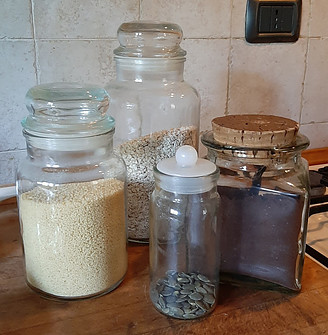
- It also won’t leak any chemicals into the food.
- Glass is sustainable and can easily be recycled. It is made of silica (sand) that occurs naturally, sodium carbonate (soda ash), calcium carbonate and cullet (glass waste).
- Glass is see-through so ideal for storing foods like cereal, pasta, flour, sugar, nuts, coffee etc. keeping the food fresh and free of bugs.
- It is breakable and could crack if frozen due to food that expands. Always check with the manufacturer that it can be used in the deep freeze.
- Glass does not always have the best sealing options, although glass canning jars do seal very well. Also, glass bottles and jars with a glass lid and a rubber seal and stainless steel clamps to seal it.
- It is easy to recycle glass is and storage containers are often made from recycled glass.
- Glass is heavy to carry around, so it is not the best choice for traveling.
- Have a look at the best glass food containers with lids here.
- Stainless steel is easy to clean, unbreakable and can withstand hot and cold temperatures.
- Many stainless steel containers are available with silicone lids, making them airtight.
- It is a long-lasting metal that can last for many generations, so waste is reduced.
- Stainless steel is recyclable and most stainless steel products contain sixty percent recycled material.
- Acidic foods should not be stored in stainless for long periods of time, as the acid might start reacting with the stainless steel and metal could start leaching into the food.
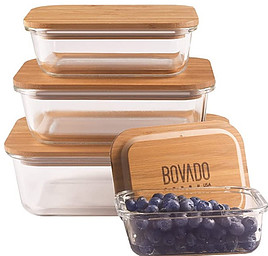
- Bamboo bases or containers with cork lids are free of BPA’s, PVC and phthalates. It is sustainable and looks stylish.
- Wood is also free of BPA’s, PVC and phthalates and will keep food cold or hot for longer than stainless steel.
- Ceramic containers can withstand temperature changes so are suitable for storing in the fridge and freezer.
- It can also be used in a conventional oven or microwave oven.
- It does not impart any chemicals and will not absorb flavors or odors from the food.
- Silicone is normally regarded as safe for food storage as it has not been shown to react with food. It is still made from plastic which is derived from fossil fuels, so it is not the most sustainable option for food storage. It is better than traditional plastic though. Make sure that you choose “food grade” silicone and it is best not to heat it. It works well as lids for glass and stainless steel storage containers. Silicon zip-up bags are also available.
The safest food storage containers are glass and stainless steel. You can also reuse sustainable food storage containers, like glass bottles and jars, in which you bought food, like peanut butter or jam. Reusing is far more sustainable than using disposable products.
Other option are to use pasta straws and take your own utensils (bamboo or metal) that can be reused. Whatever you choose, it needs to be phthalate free food storage containers.
Sneaky Sources of Plastic
There are many obvious sources of plastic like drinking straws, bags and containers, packaging, disposable cups and plates etc. But plastic is also hiding in many products that might not be so obvious to everybody, so beware the hidden plastic and see what you can do to avoid it.
- Teabags – did you know that many teabags have plastic in them?
- The alternative is to buy loose-leaf tea or look out for brands that specifically say what their teabags are made of, or organic brands use plastic free bags.
- Chip or crips bags – most bags are made from aluminium which is laminated with plastic, or plastic itself to keep the chips crispy. This type of plastic is almost impossible to recycle, although Terracycle will.
- alternative: Make your own crisps.
- Cans – many aluminium cans for coca cola and soda drinks, are lined with plastic to prevent corrosion by the content.
- Milk cartons and juice cartons – these are lined with plastic to prevent the cardboard from getting soggy and disintegrating. These cannot be recycled because of the plastic linings.
- Alternative: Buy milk in glass if possible, or if it is in a plastic bottle, at least these plastic PET bottles can be recycled.
- Paper cups and molded fiber containers are lined with plastic to prevent liquids seeping through and making it soggy and leaking the content. It is almost impossible to recycle these products because of the plastic lining.
- Alternative: if you are getting a take away, take your own keep cup for liquids or stainless steel or glass reusable containers.
- Microwaveable popcorn – once again the bags are lined with plastic which means you cannot recycle it.
- Alternative: make your own.
- Chewing gum: most chewing gum is plastic with added colors and flavors and many other additives and fillers.
- Plastic free gum is available or switch to all-natural mints or chew fresh mint.
- Glitter is colorful micro plastics and harms the environment.
- Alternative: just avoid it.
- Disposable wet wipes and baby wipes are usually cotton woven together with polyester and chemicals added for fragrances and to preserve them.
- Alternative: use old-fashioned water and soap, or make your own wipes. For wiping surfaces use cloth or paper towels with natural based cleaning solutions. You can make your own reusable wipe wipes and this is where you can find out how.
- Clothing: all synthetic fabrics release micro plastic particles when washed. The chemical in polyester, nylon, acrylic and other chemically produced fibers can be absorbed by your skin when wearing it and can cause endocrine imbalances.
- Alternative: wear natural fibers like organic cotton, hemp, linen, bamboo, silk and wool.
- Furniture and carpets – synthetic flooring made from polyurethane, polypropylene etc. contain chemicals and just like clothing, can harm us. And the same goes for furniture. Mattresses and pillows often contain synthetic fabrics.
Reduce the demand for new plastic by shopping alternatives.
We can all play our part to reduce plastic pollution: 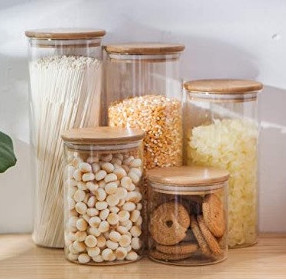
- Avoid excess food packaging
- Use reusable containers to take lunch to work
- say NO to plastic cutlery and straws (bamboo etc.)
- Choose reusable water bottles
- Use reusable shopping bags
Although some sustainable food storage containers might not be a hundred percent perfect for each situation, they are far better alternatives than using disposable products or using plastic for storing food.
You want to make sure that you are using the safest food storage containers, and that means say goodbye to plastic and have phthalate free food storage containers.
- Related posts: Guide to Stainless Steel Food Storage Container and Best Glass Food Containers with Lids.
More Tips to help the Environment
- Use rechargeable batteries – it is better for your pocket and has no acid in them.
- Unplug electrical appliances if they are not in use. Even if they are turned off, they still use a small amount of electricity.
- Buy second hand clothes.
- Use bamboo toothbrushes.
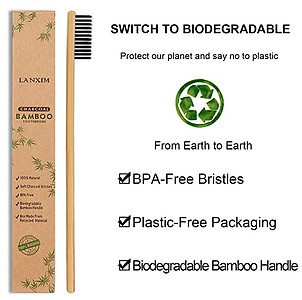
- Buy loose-leaf tea – teabags can contain micro plastics that end up in the oceans.
- Wash clothes in cold water and don’t use the drier to save electricity.
- Take car to the car wash and use less water than washing the car at home with a hosepipe running. Of course, you should be filling a bucket with water and wash it without a running hosepipe.
- Set energy saving on electrical devices so that it can automatically turn off after a certain period of inactivity.
- Give up quick or next day delivery to reduce the amount of delivery vehicles on the road. Group small orders together.
- Replace the shower head for up to date technology that uses less water.
- Use matches, rather than gas lighters.
- Reuse clothes hangers that you get with your clothes from the dry cleaners – return them to the dry cleaners or send them to metal scrap yard.
- Use biodegradable cat litter trays.
- Listen to music off-line. Streaming and downloading music uses a lot of energy.
- Reduce the brightness of your computer screen to save energy.
- Cancel spam emails.
- Use eco friendly search engines. Ecosia invests 80% of their profits to plant new trees.
- Use cloth reusable diapers or nappies.
- Have at least one meatless dinner per week. I have a meatless Monday every week, and instead enjoy just vegetables. I will have at least two other days in the week when fish will be on the menu or just veggies on their own again.
- Make your own reusable baby wipes from facecloths. Could buy flannels or towels and cut them smaller and hem them to save even more money.
There is a big selection of reusable and sustainable food storage containers available on Amazon.
Click here if you are in the USA and this is your link if you are in the UK or Europe.
I hope you have found this guide to the safest food storage containers helpful, but if you do have any suggestion or questions, please leave them below and I will get back to you.
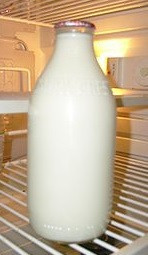
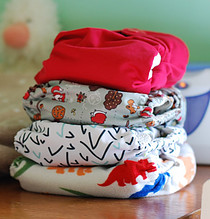

This is such a brilliant article. Personally, I absolutely loved it. I loved the thoroughness and not shying away from basically any material I could think of.
I was actually so surprised that teabags contain plastic. That’s absolutely dumb, the way I see it. I mean, why on Earth do they do that. Isn’t that like essentially drinking plastic then? Woah. And then, wait, what? Chewing gum is plastic? What the hell? I’m not a huge consumer on that but I have certainly chewed my fair share of chewing gum in my childhood days. Never again, I guess. Another realization was the cans having a plastic layer. I mean, I’ve heard of conserves using BPA but I don’t know why I taught that cans are different. I will be steering clear of those from now on.
I think I can’t say enough. This was so helpful. Thank you!!!
There is a lot of hidden plastic in our food and in containers, so one needs to be aware of it. Storing food in non-plastic containers, are so much better. It is good to know that you found the post helpful.
This is a very well researched and written article about The Safest Food Storage Containers.
Being a chef for over 30 years I have never been keen in heating stuff up in plastic containers for the reasons that you mentioned in your article.
There are many more safe options like you say, I prefer glass jars and use Mason Jars a lot at home now, they seal well and you can see the contents easily.
I like how you also mentioned about the sneaky plastic content in things that many of us would never have thought of. Tea bags? WOW.
Keep up the great research and writing.
Kevin
Thanks Kevin, I love using glass to store all my dry foods. I can see exactly what I have in each container, and it keeps it fresh for much longer. All the best, Liné
I learned a lot reading your article. Plastic is omnipresent. It’s hard to get rid of it. I try to buy sustainable option. I enjoy glass containers and ceramic containers. They are heavy for lunch boxes though. I’m thinking about sillicon ziploc bags to store in the freezer.
As for clothes, I try to buy natural fibers, but often they are mixted with plastic. I try to save money now to buy clothes that are good for the environment.
Little changes will make the difference.
It is indeed the little changes that all add up to make a difference, and we can all help to save our planet.
Hello there! Thank you so much for sharing this vital information with me. It is very important we know these things. I totally agree with everything you have said here: From my observation as a medical practitioner , plastic containers have poor physical stability due to adsorption, absorption lightness and/or interactions between the formulation and the container
The safest food storage containers avoid the use of plastic coming in contact with the food.
Hi,
Thanks so much for this enlightening article!
I have heard and read about the dangers of plastic food containers, especially when they get exposed to heat or extreme cold as in fridges. But you have cemented that knowledge for me today.
I am one of those people who will annoy many with their love for old / ancient things. I do have some stainless steel food containers. What resistance I have had to put up in the past decade, with people who want me to change the situation, perhaps for plastic! Now I have a source I can refer them to.
Regards
It is indeed best to avoid plastic for storing food and many other applications of plastic is not good for your health and the environment.
I really appreciate your article. Trying to always utilize reusable containers is something we all can make to protect our environment! Among these materials you mentioned, my favorite one is always glass – even if its weight could be a little higher if compared to other materials. Silicone is always my second alternative. You covered a very interesting topic, thank you!
I love using glass for storing dry products like tea, coffee, flour, sugar, cereal etc. and have been using them for many years. They look attractive and I can see the content. I also use stainless steel and simply love my stainless steel reusable water bottle and bento lunch boxes. I would certainly recommend them.
I’ve bookmarked this so my kids can read it during the week, thanks for such a well presented article!
I had no idea cans were lined with plastic, I honestly thought they were just aluminium plus the labels. Thanks for the info.
I think I’ll switch to glass or maybe wood after reading this as quite often my lunch is sat in my truck window. I now realise there are more hazards than just food poisoning if I’m not careful…
Thanks again,
Tony
There are many hidden plastics that can harm your health when it comes to the plastic leaching into the food or water, and I would certainly avoid a plastic water bottle. Glass and stainless steel are two of the safest materials when it comes to food storage and you can read more about it in these two related posts. Best glass food containers with lids and Guide to stainless steel food storage containers.
Information about helping the environment is always a pleasure to read so this was a lovely article that I believe so many others need to know about.
It is so important for people to understand about the harm that plastics do to our body. However, I must admit I had never realised about synthetic fibers, glitter or teabags so I am really pleased I only buy loose tea now.
I truly hope so many people read this and help the environment.
Thanks so much
Thanks Imelda, it was only when I started researching plastics and the harmful effects they have on our bodies and the environment, that I realised that it is much worse than I had thought. I now avoid plastic as much as possible.
Hello,
This was an interesting and well written article with lots of advice and tips on eliminating plastic. It really does seem to be everywhere these days.
I noticed that you recommended using rechargeable batteries. I’m currently trying to do that but find that some of them don’t hold the charge very well. Can you recommend a particular brand? I’m really keen not to buy new batteries but it’s frustrating when the rechargeable ones don’t last.
Best wishes,
Cameron
Hi Cameron, I have found that rechargeable batteries also come to the end of their lives and get to a point where they have to be replaced. It also depends on what you are using them for as certain toys and games will drain the batteries quicker than a less active application.
Having lived in different countries, there are different brands available, and not knowing where you live, I cannot recommend which one is best for you. Rechargeable batteries are not my field of expertise.
I did find that the more expensive established brands were better than cheap brands.
I hope this helps, Liné
Hello there! this is an amazing review you have got here. studies have shown that these chemicals can promote human breast cancer cell growth and lower sperm counts. Pregnant women, infants and children are especially at risk. What’s more is that all of us have BPA in our systems.
Thank you
Hi Joy, it is scary just how bad plastic is for the environment and us, so it is important to know why is plastic bad for your health. Thankfully we do have plastic free products that we can use. Liné
My goodness what an informative post. I never knew teabags had plastic in them, always thought that it was a paper bag/material. Glad I stopped chewing gum a while ago because I also didnt know that it is basically plastic. I heard that birds could choke on it and die though. This world is so full of plastic it’s actually disturbing. Makes one think twice before buying or using something.
I am certainly thinking twice about anything that is wrapped in plastic and would avoid it if possible. I find that using my own reusable bags, means I don’t have to use plastic bags and is making a big difference to my waste.
In an effort to reduce plastic food container storage I have been switching to canning jars. They are very effective, I can see what is there. I just label the lid with masking tape. I have trouble telling the difference in chili, spaghetti sauce, and enchilada sauce when frozen, as well as broths from cooking. Now- glass storage containers take more space when storing between uses. I still don’t have a satisfactory solution for that.
Thank you for the reminder of heating in plastic, I slip up there once in a while. The reminder you gave should make me more aware. Thanks as well for point out that Amazon would have the plastic-free storage items. Your list of things to do to keep us recycling was also a good reminder list of how we can help ourselves. Tea Bags with plastic in the fabric? That is sneaky!
Hi Sami, Canning jars are great for freezing and if you label the sauces with your masking tape and specify the type of sauce, it should help you. Liné
hi , thanks for sharing I am into good storage for good health. Your so knowledgeable I only know I just need all my storage to be BPA free. I will visit amazon and search more for storage the right way.
I also like the banners on the side I can also go and visit other website. Thanks for sharing.
Hi Adona, I am sure you will be able to find what is right for you, Liné
Great work to point out how bad and dangerous plastic really is. I am glad that more and more people try to make the switch to non-plastic products. Unfortunately in our society, the biggest issue is that plastic products are so damn cheap and alternatives are most of the time higher priced. This is something that needs to change. There are alternatives out there to store your food without plastic but in my opinion, it needs to be affordable for everyone too.
Hi Joe, It is unfortunate that so many people do not know why is plastic bad for your health. Most of the safest food storage containers that can be used as alternatives to plastic, are very affordable, and is certainly better for not just you, but also the environment. Liné
Thank you for this fantastic post on containers that are safe for food storage, It is amazing how plastic is so bad for our health and so bad for the environment yet is seems like this is the most popular way to store food. I’m a big fan of using glass containers for storing my food. I have done away with almost all plastic in my home.
Hi Lynne, Many people do not realise why is plastic bad for your health, but thankfully we do have alternative safe food storage containers that are available.
This article is very informative about the overuse of plastics in our daily lives. Many people are requesting that food stores supply food bags other than plastic to carry food in. There is a huge problem with plastic littering our society causing many problems for people and wildlife. The oceans have huge islands of plastic garbage floating around and it really is a disgrace. There are many other ways we could cut out plastic from our lives and getting the industry to do so would go a long way to helping people and our environment
Hi there, I fully agree with you that that there is already too much plastic around. I use my own reusable shopping bags, but there is so much unnecessary plastic packaging being used. If only more people would realise why is plastic bad for your health and also why is plastic bad for the environment.
Wow!. Such a helpful post and an eye-opener as well.
The topic you have addressed in your post – Ultimate Guide to the Safest Food Storage Containers is something we need to start considering seriously otherwise it will be too late.
I have taken note of the alternatives you have listed which can be used instead of plastic for storing food. And the sneaky sources of plastic you mentioned in your article is indeed a revelation for someone like me.
Thanks for the resourceful post.
You are surely trying to make this world a better place to live in.
Hi Nick, yes I am trying to contribute to making our homes safer and helping our planet. There are many small things that will help to make a difference and we can all help, even if it just one thing you change. I think many people do not actually realise why is plastic bad for your health, and also why is plastic bad for the environment.
Thankfully we do have sustainable food storage containers to replace plastic.
There is so much to learn from here. I didn’t know plastic really could be bad to health if used to store food I always thought it to be like the best. So generally glass made items are quite safe to use to stare food right? In my house plastic items are mostly used but will try to change and use other alternatives like stainless steel and also avoid chewing gums which I love so much.
Hi Donny, the safest food storage containers are glass and stainless steel which will not leak plastic into your food. There are chewing gums available which is not made of plastic, you just need to look at the information on the labels. All the best, Liné